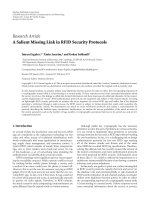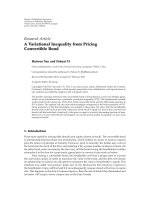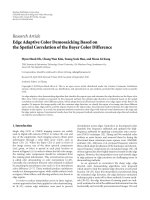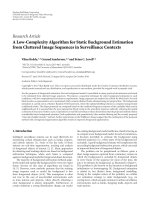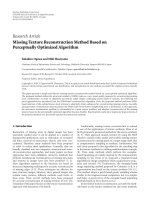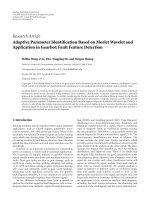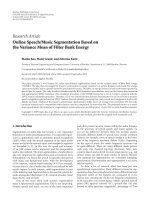Báo cáo hóa học: " Research Article A Suboptimal PTS Algorithm Based on Particle Swarm Optimization Technique for PAPR Reduction in OFDM Systems" potx
Bạn đang xem bản rút gọn của tài liệu. Xem và tải ngay bản đầy đủ của tài liệu tại đây (754.77 KB, 8 trang )
Hindawi Publishing Corporation
EURASIP Journal on Wireless Communications and Networking
Volume 2008, Article ID 601346, 8 pages
doi:10.1155/2008/601346
Research Article
A Suboptimal PTS Algorithm Based on Particle Swarm
Optimization Technique for PAPR Reduction in OFDM Systems
Jyh-Horng Wen,
1
Shu-Hong Lee,
2
Yung-Fa Huang,
3
and Ho-Lung Hung
4
1
Department of Electrical Engineering, Tunghai University, Taichung 40704, Taiwan
2
Department of Electrical Engineering, National Chung Cheng University, 168 University Road, Mig-Hsiung,
Chia-Yi 621, Taiwan
3
Graduate Institute of Networking Communication Engineering, Chaoyang University of Te chnology,
168, Jifong E. Road, Wufong Township, Taichung City 41349, Taiwan
4
Department of Electrical Engineering, Chienkuo Technology University, Changhua City, 50094, Taiwan
Correspondence should be addressed to Ho-Lung Hung,
Received 1 January 2008; Revised 30 April 2008; Accepted 27 May 2008
Recommended by Yuh-Shyan Chen
A suboptimal partial transmit sequence (PTS) based on particle swarm optimization (PSO) algorithm is presented for the low
computation complexity and the reduction of the peak-to-average power ratio (PAPR) of an orthogonal frequency division
multiplexing (OFDM) system. In general, PTS technique can improve the PAPR statistics of an OFDM system. However, it will
come with an exhaustive search over all combinations of allowed phase weighting factors and the search complexity increasing
exponentially with the number of subblocks. In this paper, we work around potentially computational intractability; the proposed
PSO scheme exploits heuristics to search the optimal combination of phase factors with low complexity. Simulation results show
that the new technique can effectively reduce the computation complexity and PAPR reduction.
Copyright © 2008 Jyh-Horng Wen et al. This is an open access article distributed under the Creative Commons Attribution
License, which permits unrestricted use, distribution, and reproduction in any medium, provided the original work is properly
cited.
1. INTRODUCTION
Orthogonal frequency division multiplexing technique
(OFDM) is a multicarrier modulation technology which can
decrease the effect of thenoise andinterferences efficiently.
Meanwhile, it has many advantages, such as: senior band
efficiency and less impact of intersymbol inference. The high
peak-to-average power ratio (PAPR) is the main drawback
of the OFDM system, in which the OFDM transmitters
require expensive linear amplifiers with wide dynamic range.
Moreover, the amplifier nonlinearity will cause intermodula-
tion products resulting in unwanted out-of-band power and
increased interference.
OFDM is an attractive technique for achieving high
bit rate wireless data transmission in frequency-selective
fading channels [1]. Recently, many schemes of reduction
in reductions PAPR have been proposed for OFDM system,
as clipping [2] and peak windowing, block coding [3],
nonlinear companding transform schemes [4, 5], active
constellation extension [6], selective mapping [7, 8], and
partial transmit sequences (PTSs) [9–17], which are the most
attractive ones due to good system performance and low
complexity. Among these methods, PTS scheme is the most
efficient approach and a distortionless scheme for PAPR
reduction by optimally combining signal subblocks. In PTS
technique, the input data block is broken up into disjoint
subblocks. The subblocks are multiplied by phase weighting
factors and then added together to produce alternative trans-
mit containing the same information. The phase weighting
factors, whose amplitude is usually set to 1, are selected
such that the resulting PAPR is minimized. The number
of allowed phase factors should not be excessively high, to
keep the number of required side information bits and the
search complexity within a reasonable limit. However, the
exhaustive search complexity of the ordinary PTS technique
increases exponentially with number of subblocks, so it is
practically not realizable for a large number of subblocks.
To find out a best weighting factor is a complex and difficult
problem. In this paper, we present a novel approach to tackle
the PAPR problem to reduce the complexity based on the
relationship between the phase weighting factors and the
subblock partition schemes.
2 EURASIP Journal on Wireless Communications and Networking
Data
source
Serial
to
parallel
and
partition
into
clusters
IFFT
length N
IFFT
IFFT
PSO based PTS
weighting factor optimization
P/S
converter
N carriers MN carriers
Side information
X
X
1
X
2
X
M
W
1
W
2
W
M
X
.
.
.
.
.
.
Figure 1: The structure of transmitter with PSO-based PTS scheme.
The rest of this paper is organized as follow. In Section 2,
definition of PAPR of OFDM system and the principles
of PTS techniques are introduced. The particle swarm
optimization (PSO) algorithm-based PTS OFDM system is
examined in Section 3. The results of simulation are dis-
cussed in Section 4 and some conclusions for the proposed
scheme are drawn in Section 5.
2. SYSTEM MODEL
2.1. OFDM systems and peak-to-average
power ratio (PAPR)
In an OFDM system with N subcarriers, the complex
baseband representation of an OFDM signal is expressed as
x(t)
=
1
√
N
N−1
n=0
X
n
e
j2π(n/N)t
,0≤ t ≤ N − 1, (1)
where X
= [X
0
X
1
··· X
N−1
]
T
is an input symbol
sequence and t stands for a discrete time index. The PAPR of
the OFDM signal sequence, defined as the ratio of the maxim
power to the average power of the signal, can be expressed by
PA P R (x)
Δ
=
Max
0≤t≤N−1
x(t)
2
E
x(t)
2
,(2)
where E[
·] denotes the expected value [18].
2.2. Optimum partial transmit sequence-OFDM
system model
The principle structure of PTS method is shown in Figure 1
as that in [15].
In PTS approach, the input data block is partitioned into
disjoint subblocks. Each subblock is multiplied by a phase
weighting factor, which is obtained by the optimization
algorithm to minimize the PAPR value. We define the data
block as a vector X
= [X
1
X
2
··· X
N
]
T
,whereN denotes
the number of subcarriers in OFDM frame. Then, X is
partitioned into M disjoint subblocks represented by the
vector X
i
, i = 1, 2, ,M such that
X
=
M
i=1
X
i
. (3)
Here, it is assumed that the clusters X
i
consist of a set
of subblocks with equal sizes. Then, the goal of the PTS
approach is to form a weighted combination of the M
subblocks which is written as
X
=
M
i=1
W
i
X
i
, W
i
= e
jφ
i
,(4)
where W
i
, i = 1,2, , M. The phase weighting factor can
be chosen freely within [0,2π). In general, the selection of
the phase weighting factors is limited to a set with finite
number of elements to reduce the search complexity. After
transforming to the time domain, the new time-domain
vector becomes
x
= IFFT
M
i=1
W
i
X
i
=
M
i=1
W
i
IFFT
X
i
. (5)
These partial sequences are independently rotated by
phase weight factors W
i
, i = 1, 2, , M. The optimal
phase weighting factor W
i
that minimizes the PAPR can be
obtained from a comprehensive simulation of all possible
2
M−1
combination. The objective of the PTS technique is to
choose a phase weighting vector W
={W
1
, W
2
, , W
i
} to
reduce the PAPR of X
, and the optimum parameters for an
OFDM symbol can be by
W = argmin
W
max
M
i=1
W
i
X
i
. (6)
The known subblock partitioning can be classified into
three categories. The first and the simplest category is called
adjacent method which allocates N/M successive symbols
to the same subblock. The second category is based on
interleaving. In this method, the symbols with distance M
Jyh-Horng Wen et al. 3
Start
define solution space
Generate initial population random position
and velocity vectors
Evaluate finess of each particle and
store the global and person best positions
Check stop
criteria
Decision
taken
Update the personal and
global best position
according to the fitness value
Update each particles
velocity and position
Adjust inertial weight
monotonically
decreasing function
End
Ye s
No
G
= G +1
Figure 2: MPSO algorithm flowchart.
areallocated to the same subblock. The last one is called
random partitioning method in which the input symbol
sequence is partitioned randomly. The random partitioning
is known as to have the best performance in PAPR reduction
[16]. It is well known that the PAPR performance will
be improved as the number of subblocks M is increased
for OPTS technique, optimum PAPR can be found after
searching 2
M−1
computation if the number of subblock is M.
A preset threshold can be used to reduce the computational
complexity. We search the PAPR values through phase
optimizer and the search is stopped once the PAPR drops
bellow the preset threshold. By this way, the computational
complexity can be significantly reduced.
3. PARTICLE SWARM OPTIMIZATION-BASED PTS
Basically, the PSO [19–27] technique-based PTS technique
described below can be implemented by appropriately
changing the optimization for block W in Figure 1. In this
context, the population is called a swarm and the individuals
are called particles. Resembling the social behavior of a
swarm of bees to search the location with the most flowers
in a field, the optimization procedure of PSO is based on a
population of particles which fly in the solution space with
velocity dynamically adjusted according to its own flying
experience and the flying experience of the best among the
swarm.
Figure 2 shows the flow chart of a PSO algorithm. During
the PSO process, each potential solution is represented as
a particle with a position vector x, referred to as phase
weighting factor and a moving velocity represented as W
and v,respectively.ThusforaK-dimensional optimiza-
tion, the position and velocity of the ith particle can
be represented as W
i
= (W
i,1
, W
i,2
, , W
i,K
)andV
i
=
(v
i,1
, v
i,2
, , v
i,K
), respectively. Each particle has its own best
position W
P
i
= (W
i,1
, W
i,2
, , W
i,K
) corresponding to the
individual best objective value obtained so far at time t,
referred to as pbest. Theglobalbest(gbest)particleisdenoted
by W
G
=(W
g,1
, W
g,2
, , W
g,K
), which represents the best
particle found so far at time t in the entire swarm. The new
velocity v
i
(t + 1) for particle i is updated by
v
i
(t +1)
= wv
i
(t)+c
1
r
1
W
P
i
(t) −W
i
(t)
+ c
2
r
2
W
G
(t) −W
i
(t)
,
(7)
where v
i
(t) is the old velocity of the particle i at time t.
Apparent from this equation, the new velocity is related to
theoldvelocityweightedbyweightw and also associated
to the position of the particle itself and that of the global
best one by acceleration factors c
1
and c
2
.Thec
1
and
c
2
are therefore referred to as the cognitive and social
rates, respectively, because they represent the weighting
of the acceleration terms that pull the individual particle
toward the personal best and global best positions. The
inertia weight w in (7) is employed to manipulate the
impact of the previous history of velocities on the cur-
rent velocity. Generally, in population-based optimization
4 EURASIP Journal on Wireless Communications and Networking
methods, it is desirable to encourage the individuals to
wander through the entire search space, without clustering
around the local optima, during the early stage of the
optimization.
A suitable value for w(t) provides the desired balance
between the global and local exploration ability of the
swarm and, consequently, improves the effectiveness of the
algorithm. Experimental results suggest that it is preferable to
initialize the inertia weight to a large value, giving priority to
global exploration of the search space, linear decreasing w(t)
so as to obtain refined solutions [20–22]. For the purpose
of intending to simulate the slight unpredictable component
of natural swarm behavior, two random functions r
1
and
r
2
are applied to independently provide uniform distributed
numbers in the range [0, 1] to stochastically vary the relative
pull of the personal and global best particles. Based on the
updated velocities, new position for particle i is computed
according the following equation:
W
i
(t +1)= W
i
(t)+v
i
(t +1). (8)
The populations of particles are then moved according
to the new velocities and locations calculated by (7)and(8),
and tend to cluster together from different directions. Thus,
the evaluation of each associate fitness of the new population
of particles begins again. The algorithm runs through these
processes iteratively until it stops. In this paper, the current
positioncan be modified by [24]
w(t)
= w
max
−
w
max
− w
min
iter
max
×
iter, (9)
where w
max
is the initial weight, w
min
is the final weight,
iter
max
is maximum number of iterations, and iter is the
current iteration number. The procedures of standard PSO
can be summarized as follows.
Step 1. Initialize a population of particles with random
positions and velocities, where each particle contains K
variable.
Step 2. Evaluate the fitness values of all particles, let pbest
of each particle and its objective value equal to its current
position and objective value, and let gbest and its objective
value equal to the position and objective value of the best
initial particle.
Step 3. Update the velocity and position of each particle
according to (7)and(8).
Step 4. Evaluate the objective values of all particles.
Step 5. For each particle, compare its current objective value
with the object value of its pbest.Ifcurrentvalueisbetter,
then update pest and its object value with the current
position and objective value. Furthermore, determine the
best particle of current warm with the best objective values.
If the objective value is better than the object value of gbest,
then update gbest and its objective value with the position
and objective value of the current best particle.
P
r
(PAPR > PAPR
0
)
10
−4
10
−3
10
−2
10
−1
10
0
PAPR
0
(dB)
468101214
Original OFDM
PSO G
n
= 1
PSO G
n
= 5
PSO G
n
= 10
PSO G
n
= 20
PSO G
n
= 30
PSO G
n
= 40
OPTS
Figure 3: CCDF of PSO technique for different G
n
when M = 16
and W
= 4.
Step 6. Termination criteria: if a predefined stopping cri-
terion is met, then output gbest and its objective value;
otherwise go back to Step 3.
4. SIMULATION RESULTS AND DISCUSSIONS
To evaluate and to compare the performance of the sub-
optimal PTS, numerous computer simulations have been
conducted todetermine the PAPR improvements. QPSK
modulation is employed with N
= 256 subcarriers. The
phase weighting factors W
= [0, 2π) have been used. In order
to generate the complementary cumulative distribution
function (CCDF) [18] of the PAPR, 10000 random OFDM
frames have been generated. The sampling rates for an accu-
rate PAPR need to be increased by 4 times. The cumulative
distribution function (CDF) of the PAPR is one of the most
frequently used performance measures for PAPR reduction
techniques. The CDF of the amplitude of a signal sample
is given by CDF
= 1 − exp(PAPR
0
). In the performance
comparison, the parameter of CCDF is defined as
CCDF
= P
r
PAPR > PAPR
0
=
1 − P
r
PAPR ≤ PAPR
0
=
1 −
1 − exp
−
PAPR
0
N
.
(10)
In Figure 3, some results of the CCDF of the PAPR
are simulated for the OFDM system with 256 subcarriers,
in which M
= 16 subblockemploying random partition
and the phase weight factor W
={±1}
M
uniformly
distributed random variables are used for PTS. As we can
see that the CCDF of the PAPR is gradually promoted upon
increasing the numbers of generations due to the limited
phase weighting factor. As the numbers of generation are
increased, the CCDF of the PAPR has been improved. For
Jyh-Horng Wen et al. 5
a generation G
n
= 40, we can see that the PSO-based PTS
technique is capable of attaining a near OPTS technique
performance, when P
r
(PAPR > PAPR
0
) = 10
−3
.
In Figure 3, we compare the PAPR performance of
different numbers of particle generations G
n
for c
1
= c
2
=
2. Basically, the PAPR performance is improved with G
n
increasing. However, the degree of improvement is limited
when G
n
is above 40. On the other hand, the computational
complexity is increased with G
n
. Only a slight improvement
is attained for increasing G
n
= 20 to 40. The computational
complexity of G
n
= 40 is double of that of G
n
= 20. Hence,
based on the trade-off between the PAPR reduction and
computational complexity, G
n
= 20 is a suitable choice for
our proposed PSO-based PTS technique.
Figure 4 shows the simulated results of the PSO-assisted
PTS technique, in comparison against normal OFDM for
number of subblocks M. M is one of value in the set
{2, 4, 8, 16, 32}. In particular, the PAPR of an OFDM signal
exceeds 12 dB for 10
−3
of the possible transmitted OFDM
blocks. However, by introducing PTS approach with M
= 16
clusters partition with phase factors limited to W
= 4, the
10
−3
PAPR reduces to 7.5 dB. In short, new approach can
achieve a reduction of PAPR by approximately 3.5 dB at the
10
−3
PAPR. Thus, the performance of the techniques is better
for larger M since larger numbers of vectors are searched
for larger M in every update of the phase weighting factors.
Moreover, it can be observed that probability of very high
peak power has been increased significantly if PTS techniques
are not used. As the number of subblocks and the set of phase
weighting factor are increased, the performance of the PAPR
reduction becomes better. However, the processing time gets
longer because of much iteration. From Figure 4,asexpected,
the improvement increases as number of clusters increases.
Thus, using the PSO technique, we can obtain better results
than presented previously.
The subblock partition for proposed suboptimal method
involves dividing the subblocks into multiple disjoint
subblocks. Therefore, determining which subblock parti-
tion method produces the best performance is important.
Figure 5 shows that the subblock partition for proposed sub-
optimal method involves three dividing subblocks: adjacent
method, interleaving method, and pseudorandom method.
In the viewpoint of PAPR reduction, pseudorandom sub-
block partitioning has better performance than others.
In Figure 6, for a fixed number of clusters, the phase
weighting factor can be chosen from a larger set of
{2, 4, 8, 16}. It is shown that the added degree of freedom in
choosing the combining phase weighting factors provides an
additional reduction. When the number of phase weighting
factor W
= 2 and number of subblocks M = 4, PAPR can be
reduced about 2.78 dB at 10
−4
from 12 dB to 9.22 dB. When
W
= 4andM = 4, at 10
−4
PAPR can be reduced about 4.2 dB
from 12 dB to 7.8 dB. As the number of subblocks and the set
of phase weighting factor are increased, the performance of
the PAPR reduction becomes better. However, the processing
time gets longer because of much iteration.
In this section, a threshold is also applied to reduce
calculation complexity and is calculated from the CCDF
equation, which has given optimal threshold for the number
P
r
(PAPR > PAPR
0
)
10
−4
10
−3
10
−2
10
−1
10
0
PAPR
0
(dB)
2 4 6 8 10 12 14 16
Original OFDM
M
= 2
M
= 4
M
= 8
M
= 16
M
= 32
OPTS
Figure 4: CCDF of the PAPR with the PTS technique searched by
PSO technique when N
= 256, M = 2, 4, 8, 16, and 32.
P
r
(PAPR > PAPR
0
)
10
−4
10
−3
10
−2
10
−1
10
0
PAPR
0
(dB)
2 4 6 8 10 12 14 16 18
Original OFDM
PSO-PTS with adjacent
PSO-PTS with interleaver
PSO-PTS with random
OPTS
Figure 5: CCDF comparisons of OFDM signal among different
subblock partition strategies.
of subblocks as follows. When N subcarriers and M sublocks
are assumed, the probability that the PAPR will exceed
certain of PAPR
0
is represented [18]as
P
r
PAPR > PAPR
0
=
1 −
1 − exp
PAPR
0
N
M
. (11)
From (11), PAPR
0
ofthreshold ζ, which is satisfied with given
probability CCDF, can be represented as
ζ
= 10 log
−
ln
1 − 10
log(1−10
log p/M
)/N
(12)
which p is pr
{}.
6 EURASIP Journal on Wireless Communications and Networking
Table 1: The computational complexity of the OPTS, IPTS and PSO-PTS techniques with phase weighting factor W = 2.
Method Computation complexity P
r
(PAPR > PAPR
0
) = 0.0001
OPTS W
M−1
= 2
8−1
= 128 7.6 dB
IPTS W
× M = 2 ×8 = 16 8.4 dB
PSO-PTS V
× O(W
3
) = (1 + G
n
) ×O(W
3
) = (1 + 10) × (2
3
) = 11 × 8 = 88 8.0 dB
PSO-PTS with threshold 23 7.6 dB
P
r
(PAPR > PAPR
0
)
10
−4
10
−3
10
−2
10
−1
10
0
PAPR
0
(dB)
4 6 8 1012141618
Original OFDM
PSO-PTS (M
= 2, W = 2)
PSO-PTS (M
= 2, W = 4)
PSO-PTS (M
= 2, W = 8)
PSO-PTS (M
= 2, W = 16)
PSO-PTS (M
= 4, W = 2)
PSO-PTS (M
= 4, W = 4)
PSO-PTS (M
= 4, W = 8)
PSO-PTS (M
= 4, W = 16)
Figure 6: Comparisons of PSO-PTS technique under different
phase weight factors and number of subblocks.
The CCDF, P
r
(PAPR > PAPR
0
)forM = 8, is shown
in Figure 7.The10
−4
PAPR of an original OFDM frame
was 12 dB. OPTS and the PSO-PTS improved on this by
7.6 dB with nearly the same performance for M
= 8, while
the performance loss with the iteration PTS is 8.4 dB. The
iteration number of proposed technique is shown in Ta ble 1.
For M
= 8, the OPTS technique requires 128 iterations per
OFDM frame, while iteration PTS technique requires 16
iterations and the PSO-PTS technique without a threshold
requires 88 iterations per OFDM frame. The complexity of
iteration PTS is only 12.5% (16/128) of that of the PTS
technique. The PSO-PTS technique with a threshold value is
exhibited a lower complexity that only requires 23 iterations
per OFDM frame. Thus, compared to the OPTS technique,
the complexity of the PSO-PTS with threshold is only 18%
(23/128
= 0.18).
Figure 8 illustrates some performance of the PTS tech-
nique in PAPR reduction for OFDM using PSO with
acceleration factors c
1
and c
2
when N = 128, M = 4, and W =
2. It can be seen that when the acceleration factors increases
resulted in the PAPR depression increasing. For example, at
the level of CCDF being 0.1%, the acceleration factors c
1
=
0.5 and c
2
= 0.5, the PAPR is 8.3 dB, and acceleration factors
c
1
= 2andc
2
= 2, the PAPR is 6.8 dB. By these two examples of
the acceleration factors c
1
and c
2
, the improvement in PAPR
reduction is about 1.5 dB. Furthermore, we see that the PAPR
P
r
(PAPR > PAPR
0
)
10
−4
10
−3
10
−2
10
−1
10
0
PAPR
0
(dB)
46810121416182022
Iterative PTS (iteration
= 16)
PSO-PTS (iteration
= 88)
OPTS (iteration
= 128)
PSO-PTS with threshold
(iteration
= 23)
Original OFDM
Figure 7: Comparison of the PSO-PTS technique with threshold
PAPR, iterative PTS, PSO-PTS, and OPTS methods when M
= 8.
P
r
(PAPR > PAPR
0
)
10
−4
10
−3
10
−2
10
−1
10
0
PAPR
0
(dB)
46810
c
1
= 0.5 c
2
= 0.5
c
1
= 1 c
2
= 1
c
1
= 1.5 c
2
= 1.5
c
1
= 1.5 c
2
= 2
c
1
= 2 c
2
= 1.5
c
1
= 2 c
2
= 2
c
1
= 2 c
2
= 2.5
c
1
= 2.5 c
2
= 2
Figure 8: CCDFs comparison of the PSO-based PTS scheme with
different combinations of acceleration constants when N
= 128, M
= 4, and W = 2.
reduction of c
1
= 2andc
2
= 2; and c
1
= 2.5 and c
2
= 2
have similar performance. Hence, after taking the effect of the
Jyh-Horng Wen et al. 7
reduction and the computational complexity into account, c
1
= 2andc
2
= 2 is a suitable choice for our proposed PSO-based
PTS technique. The values of c
1
and c
2
affect the behavior
of the swarm in different ways: a bigger c
1
can increase the
attraction of W
P
i
for every particle and prevent the particle
converging to W
G
quickly, while a bigger c
2
can decrease the
attraction of W
P
i
and prompt the swarm converging to the
same W
G
.
5. CONCLUSION
In this paper, we analyze the PAPR reduction performance
which is derived by using adjacent, interleaved, and random
subblock partitioning methods. Random subblock partition-
ing method has derived the most effective performance, and
interleaved subblock partition method has derived the worst.
As the number of subblocks is increased, PAPR can be further
reduced. Moreover, we formulate the phase weighting factors
searching of PTS as a particular combination optimization
problem and we apply the PSO technique to search the
optimal combination of phase weighting factors for PTS to
obtain almost the same PAPR reduction as that of optimal
PTS while keeping low complexity. Simulations results show
that PSO-based PTS method is an effective method to
compromise a better tradeoff between PAPR reduction and
computation complexity. By appropriate selection of phase
weighting factors according to the required performance
and tolerable complexity, the proposed partition scheme
can be adaptive to QOS requirement. We illustrated that
with this method we can develop algorithms which can
achieve better performance-complexity tradeoff than the
existing approaches. Additionally, the performance of the
proposed method was slightly degraded compared to that
of optimum method, PTS. However, the complexity of
the proposed method was remarkably lower than that of
optimum method.
ACKNOWLEDGMENT
This work is supported by the National Science Council,
Taiwan, under Grant no. NSC-96-2221-E-029-031-MY2.
REFERENCES
[1]S.H.HanandJ.H.Lee,“PAPRreductionofOFDMsignals
using a reduced complexity PTS technique,” IEEE Signal
Processing Letters, vol. 11, no. 11, pp. 887–890, 2004.
[2] X. Li and L. J. Cimini Jr., “Effects of clipping and filtering
on the performance of OFDM,” IEEE Communications Letters,
vol. 2, no. 5, pp. 131–133, 1998.
[3] T. Jiang and G. Zhu, “Complement block coding for reduction
in peak-to-average power ratio of OFDM signals,” IEEE
Communications Magazine, vol. 43, no. 9, pp. S17–S22, 2005.
[4] T. Jiang and G. Zhu, “Nonlinear companding transform for
reducing peak-to-average power ratio of OFDM signals,” IEEE
Transactions on Broadcasting, vol. 50, no. 3, pp. 342–346, 2004.
[5] T. Jiang, W. Yao, P. Guo, Y. Song, and D. Qu, “Two novel
nonlinear companding schemes with iterative receiver to
reduce PAPR in multi-carrier modulation systems,” IEEE
Transactions on Broadcasting, vol. 52, no. 2, pp. 268–273, 2006.
[6] Z. Yang, H. Fang, and C. Pan, “ACE with frame interleaving
scheme to reduce peak-to-average power ratio in OFDM
systems,” IEEE Transactions on Broadcasting,vol.51,no.4,pp.
571–575, 2005.
[7] C L. Wang and Y. Ouyang, “Low-complexity selected map-
ping schemes for peak-to-average power ratio reduction in
OFDM systems,” IEEE Transactions on Signal Processing, vol.
53, no. 12, pp. 4652–4660, 2005.
[8]H.Breiling,S.H.Muller,andJ.B.Huber,“SLMpeak
power reduction without explicit side information,” IEEE
Communication Letters, vol. 5, no. 6, pp. 239–241, 2001.
[9] S. H. Muller and J. B. Huber, “OFDM with reduced peak-
to-average power ratio by optimum combination of partial
transmit sequences,” Elect ronics Letters, vol. 33, no. 5, pp. 368–
369, 1997.
[10] S. G. Kang, J. G. Kim, and E. K. Joo, “A novel subblock
partition scheme for partial transmit sequence OFDM,” IEEE
Transactions on Broadcasting, vol. 45, no. 3, pp. 333–338, 1999.
[11] W. S. Ho, A. S. Madhukumar, and F. Chin, “Peak-to-average
power reduction using partial transmit sequences: a subopti-
mal approach based on dual layered phase sequencing,” IEEE
Transactions on Broadcasting, vol. 49, no. 2, pp. 225–231, 2003.
[12]D W.Lim,S J.Heo,J S.No,andH.Chung,“AnewPTS
OFDM scheme with low complexity for PAPR reduction,”
IEEE Transactions on Broadcasting, vol. 52, no. 1, pp. 77–82,
2006.
[13] L. Yang, R. S. Chen, Y. M. Siu, and K. K. Soo, “PAPR reduction
of an OFDM signal by use of PTS with low computational
complexity,” IEEE Transactions on Broadcasting, vol. 52, no. 1,
pp. 83–86, 2006.
[14] A. D. S. Jayalath and C. Tellambura, “Adaptive PTS approach
for reduce of peak-to-average power ratio of OFDM signal,”
Electronics Letters, vol. 36, no. 14, pp. 1226–1228, 2000.
[15] L. J. Cimini Jr. and N. R. Sollenberger, “Peak-to-average power
ratio reduction of an OFDM signal using partial transmit
sequences,” IEEE Communication Letters, vol. 4, no. 3, pp. 86–
88, 2000.
[16] S. G. Kang, J. G. Kim, and E. K. Joo, “A novel subblock
partition scheme for partial transmit sequence OFDM,” IEEE
Transactions on Broadcasting, vol. 45, no. 3, pp. 333–338, 1999.
[17] O J. Kwon and Y H. Ha, “Multi-carrier PAP reduction
method using sub-optimal PTS with threshold,” IEEE Trans-
actions on Broadcasting, vol. 49, no. 2, pp. 232–236, 2003.
[18] S. H. Han and J. H. Lee, “An overview of peak-to-average
power ratio reduction techniques for multicarrier transmis-
sion,” IEEE Wireless Communications, vol. 12, no. 2, pp. 56–65,
2005.
[19]A.Ratnaweera,S.K.Halgamuge,andH.C.Watson,“Self-
organizing hierarchical particle swarm optimizer with time-
varying acceleration coefficients,” IEEE Transactions on Evolu-
tionary Computation
, vol. 8, no. 3, pp. 240–255, 2004.
[20] M. Clerc and J. Kennedy, “The particle swarm—explosion,
stability, and convergence in a multidimensional complex
space,” IEEE Transactions on Evolutionary Computation, vol. 6,
no. 1, pp. 58–73, 2002.
[21] Y. Shi and R. Eberhart, “A modified particle swarm opti-
mizer,” in Proceedings of the IEEE International Conference on
Evolutionary Computation (ICEC ’98), pp. 69–73, Anchorage,
Alaska, USA, May 1998.
[22] D. J. Krusienski and W. K. Jenkins, “Design and performance
of adaptive systems based on structured stochastic optimiza-
tion strategies,” IEEE Circuits and Systems Magazine, vol. 5, no.
1, pp. 8–20, 2005.
8 EURASIP Journal on Wireless Communications and Networking
[23] W C. Liu, “Design of a multiband CPW-fed monopole
antenna using a particle swarm optimization approach,” IEEE
Transactions on Antennas and Propagation, vol. 53, no. 10, pp.
1–7, 2005.
[24] J. Robinson and Y. Rahmat-Samii, “Particle swarm optimiza-
tion in electromagnetics,” IEEE Transactions on Antennas and
Propagation, vol. 52, no. 2, pp. 397–407, 2004.
[25] A. Torn and A. Zilinkas, Global Optimization, vol. 350 of
Lecture Notes in Computer Science, Springer, New York, NY,
USA, 1989.
[26] J. Kennedy, R. C. Eberhart, and Y. Shi, Swarm Intelligence,
Morgan Kaufmann, San Mateo, Calif, USA, 2001.
[27] H L. Hung, Y F. Huang, and J H. Wen, “A particle swarm
optimization based multiuser detector for DS-CDMA com-
munication systems,” in Proceedings of the IEEE International
Conference on Systems, Man and Cybernetics (SMC ’06), vol. 3,
pp. 1956–1961, Taipei, Taiwan, October 2006.

